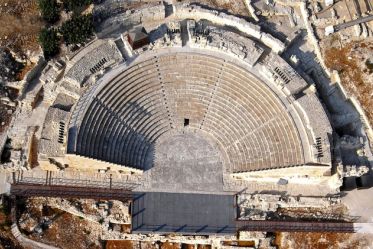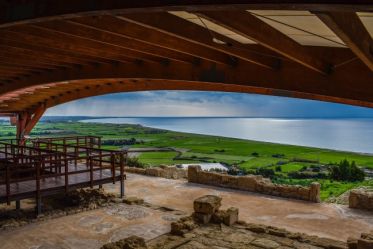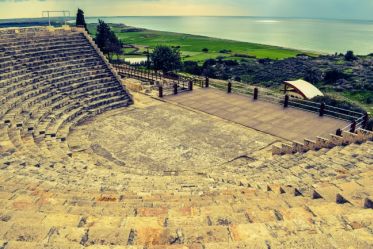![]() +357 24 828 100
+357 24 828 100
![]() +357 24 828 100
+357 24 828 100
Kourion was one of the island’s most important city-kingdoms in antiquity, built on a hill surrounded by the Kouris River Valley - 13 km west of Limassol.
According to archaeological findings, the earliest evidence of settlement in the broader area of Kourion dates to the Neolithic period (5500-3900 B.C.) whilst the most ancient remains in the general area of the ancient city are associated with settlements and tombs of the Middle and Late Bronze Age. In 365 AD the once-flourishing kingdom was eventually destroyed in a severe earthquake.
The most impressive remains that can be seen today are the Agora , The House of Achilles ,the House of Gladiators, The Baths and House of Eustolios, the Small Basilica next to the Stadium, the Cathedral of Kourion and of course The Theatre .
The Agora: The Roman Agora in its present state is a structure of the early 3rd century A.D. with additions dating to the Early Christian period. It was built on the remains of an earlier public building, which was in use from the end of the 4th century to the end of the Hellenistic period. The Agora is surrounded on both sides by porticos with marble columns. An impressive public bath and a Nymphaeum, which supplied the city with water, occupy the northwest side of the Agora.
The House of Achilles: It was a Roman villa constructed in the early-fourth century CE.The only part of the building, preserved today is situated at the northwestern end of Kourion near the old Lemesos-Pafos road. Several rooms are decorated with mosaic floors. The most interesting floor depicts the popular story of the revealing of Achilles' true identity by Odysseus in the court of the king Lycomedes at Skyros when his mother, Thetis, had hidden him there amongst the women so that he might not be sent to war against the Trojans The excavators suggest that this was a civic reception centre for distinguished visitors.
House of the Gladiators: The so-called House of the Gladiators is located south and east of the House of Achilles. The structure dates to the late-third century CE. It is interpreted as an elite-private residence, or perhaps more probably as a public palaestra. The later identification is supported by the absence of many rooms appropriate for living spaces and that the structure was entered from the east through the attached bath complex. The main wing of the structure is arranged around a central peristyle courtyard, the northern and eastern porticos of which possess preserved mosaic pavements depicting gladiatorial combats. The eastern portico of the atrium contains two panels depicting gladiators in combat, the only such mosaics in Cyprus.
The Small Basilica It dates to the 5th century A.D., situated next to the stadium. The basilica had a narthex and an atrium with four porticos in the west. In the middle of the atrium there was a reservoir that was destroyed and replaced by a medieval limestone kiln. Adjoining the basilica to the north was a corridor and a chapel.
The Baths and House of Eustolios: constructed in the late-4th century over the remains of a structure destroyed in the mid-4th century, The Baths and House of Eustolios are situated on the crest of the southern cliffs immediately above the theatre. A mosaic inscription in the eastern portico identifies the building as Eustolios, who built the structure to alleviate the suffering of the populace of Kourion, presumably in response to the earthquakes of the mid-to-late 4th century. The southern peristyle was arranged around a central pool and is the centerpiece of the household, its porticoes adorned with elaborate mosaics. A salutatory inscription in the vestibule beyond the forecourt reads -"Enter for the good luck of the house."
The baths themselves originally opened off the central room to the north and east, where there were cold baths (frigidarium). Before each is a shallow foot-bath; while on the west, the remains of the hypocausts - which heated the medium room (tepidarium), and the hot room (caldarium) - can be seen. In the latter, the built-in basins for hot baths have survived, as have the firing chambers, where hot air was carried through the hypocausts, travelling up through specially-cut flues, through the walls, and beneath the terracotta tiles of the floor.
Episcopal Precinct and Cathedral of Kourion: The episcopal precinct of Kourion, located along the crest of the cliffs immediately southwest of the forum, was constructed at the beginning of the 5th century and renovated successively in the 6th century CE. The precinct was destroyed during the Arab raids of the 7th century, after which the seat of the Bishop of Kourion was moved inland where the village of Episkopi was established.
The Stadium: The Stadium of Kourion lies 1km to the west, on the right side of the road towards Pafos. It has a U-shaped plan and has seven rows of seats which would have accommodated around 6000 spectators. It was built in the 2nd century A.D. and was used until the end of the 5th century.
The Theatre: The magnificent Greco-Roman theatre – the site’s centerpiece - was built in the 2nd century BC and extended in the 2nd century AD. The theatre has been restored, and is now used for open-air musical and theatrical performances - mainly during the summer months - making it one of the most popular settings for high-caliber cultural events. It has a capacity of 3000 spectators.
The Kourion Archaeological Area, and all antiquities within the Akrotiri West Sovereign Base are managed by the Cyprus Department of Antiquity. Kourion is a listed UNESCO World Heritage Site.
Accessibility: Almost all the site is wheelchair accessible: small bridges and passageways available (The site´s western part can be accessed via a special entrance that can be opened by the site´s guards) Special rest rooms and special parking space also available


